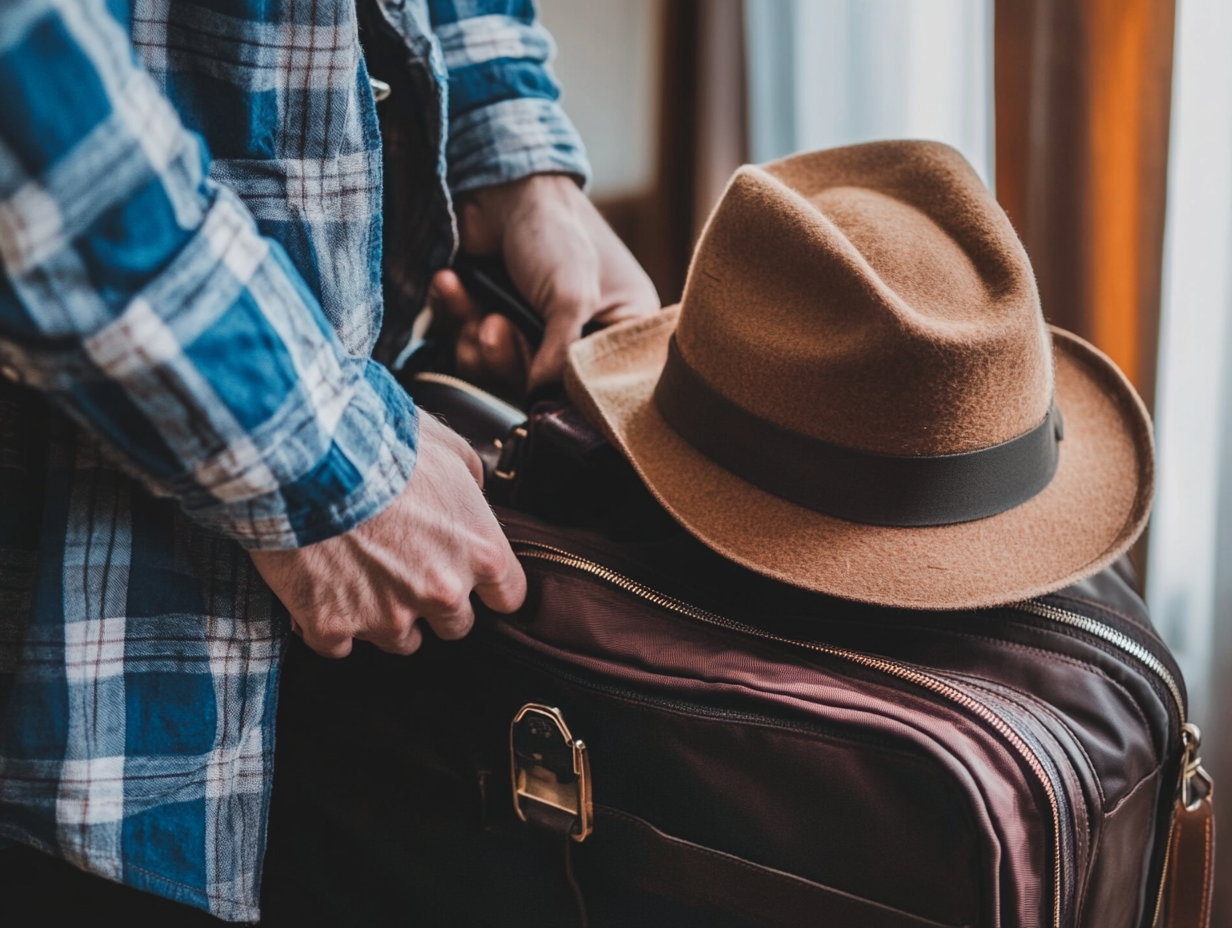Editor Picks
Sorry, Posts you requested could not be found...
latest posts
There’s something magical about returning from a trip with memories, stories, and a renewed sense of wonder about the world. But why should that inspiration fade when you walk through your front door?
Travel-inspired home decor has become one of the most meaningful ways to keep that adventurous spirit alive, creating spaces that tell your story while inspiring future journeys.
The Rise of Travel Decor in 2025
As interior design trends in 2025 emphasize that people are seeking spaces within their homes that reflect their authentic selves, and what’s more personal than the places that have touched your heart?
Travel design can be represented in a number of ways including exotic souvenirs, framed vintage maps, light timber grains, plants, authentic textiles, functional shelving units, repurposed vintage suitcases, coastal colors and natural tones. The key is creating a narrative that feels both sophisticated and deeply personal.
Start with a Simple Color Story
Interior designer Leanne Ford emphasizes the importance of restraint when creating travel-inspired spaces. “Stick to two to three colors at most,” she recommends. Hues like beige, tan, and grey create a blank slate that won’t make your home look like a sterile museum while allowing your collected treasures to shine.
These neutral bases work particularly well in Indian homes, complementing natural materials like wood and stone while providing a sophisticated backdrop for colorful textiles and artwork collected during travels.
World Maps: More Than Just Wall Art
World map wall art has evolved far beyond basic geography lessons. Today’s options range from wooden sculptural pieces to interactive push-pin maps where you can mark your adventures. These decorative wall designs create an inspirational atmosphere that sparks new adventures while serving as conversation starters.
Consider a large-scale vintage world map as a statement piece in your living room, or create a gallery wall featuring maps of places you’ve visited alongside photos from those trips. The key is choosing pieces that feel authentic to your travel experiences rather than generic tourist decorations.
Textiles That Tell Stories
Nothing captures the essence of a place quite like its textiles. Moroccan rugs, Indian block prints, Peruvian throws, or Turkish towels can instantly transport you back to bustling markets and memorable discoveries. The beauty lies in mixing patterns and textures from different cultures while maintaining color harmony.
Layer these textiles thoughtfully throughout your home. A vintage kilim rug in the living room, embroidered cushions from your Southeast Asian adventure, or a handwoven throw from your mountain retreat can add warmth and personality without overwhelming the space.
Functional Travel Decor
The most successful travel-inspired homes incorporate pieces that are both beautiful and practical. Repurposed vintage suitcases make excellent coffee tables or storage solutions. Moroccan lanterns provide ambient lighting while adding architectural interest. Carved wooden bowls from Bali can hold keys by the entrance or serve snacks to guests.
This approach aligns perfectly with 2025’s emphasis on combining style with functionality, creating homes that work as hard as they look good.
Plants and Natural Elements
Travel often connects us with nature in profound ways – from tropical beaches to mountain forests. Bring those memories home through carefully chosen plants and natural elements. A collection of succulents might remind you of desert adventures, while lush ferns could recall tropical getaways.
Driftwood, shells, stones, and other natural souvenirs can be displayed artfully without creating clutter. The key is editing your collection to showcase only the most meaningful pieces.
Creating Vignettes with Meaning
Instead of scattering travel mementos throughout your home, create intentional vignettes that tell specific stories. A console table might feature items from your European adventure – a small ceramic piece from Portugal, a vintage postcard from Paris, and a guidebook that led you to hidden gems.
These curated displays feel more sophisticated than random collections while keeping your travel memories front and center in your daily life.
The Sophisticated Approach
The secret to successful travel-inspired decor lies in curation over accumulation. Choose pieces that truly speak to you rather than buying souvenirs for the sake of it. Quality trumps quantity, and meaningful items always outshine generic tourist merchandise.
Planning a trip soon? These simple yet powerful tricks could make all the difference between travel chaos and a stress-free getaway. Let’s just say, you will never look at flight booking or packing the same way again.
Frequent flyers have a few tricks up their sleeves – clever hacks that make planning quicker, packing neater, and journeys far more enjoyable. From budget-friendly bookings to carry-on wizardry, these small strategies go a long way. Don’t worry if you are still learning the ropes. Travel and lifestyle influencer Katie Froom, a UK native living in Australia, has shared her go-to travel hacks on Instagram, and they are gold. Whether you are travelling solo or with family, these tips will help you fly smart, save money, and keep your chill.
8 Flight Hacks One Needs To Know Before Their Next Trip:
1. Book On The Right Day:
According to Katie, Tuesdays and Wednesdays are often the cheapest days to fly. Steer clear of weekend bookings, when fares tend to spike. That said, flexibility is key-monitor price patterns over time to strike the best deals.
2. Go Incognito While Searching:
Flight prices can shoot up if you search repeatedly, thanks to cookies and trackers. Katie suggests always using incognito mode when browsing. But remember, prices also change based on demand, availability, and timing, not just your search history.
3. Pack Smarter, Not Heavier:
Packing cubes = game changer. Katie recommends using them to stay organised and rolling clothes to save space. Wear bulkier items on the plane and prioritise layering, reusable outfits, and weather-ready essentials.
4. Maximise Your Carry-On Space:
Double-check airline baggage rules and pack essentials like snacks, a phone charger, and one extra outfit. Use every inch: stash socks in shoes, line up your toiletries, and compress where you can.
5. Carry An Empty Bottle:
Skip pricey bottled water at the airport. Bring your own empty reusable bottle and fill it after clearing security. Bonus? It is eco-friendly and keeps you hydrated through long queues and dry cabin air.
6. Download Everything Before You Fly:
From offline maps to boarding passes, download key information before reaching the airport. Katie also recommends using a VPN from a cheaper country to score better deals – a neat trick for tech-savvy travellers.
7. Set Flight Alerts Early:
Use apps like Google Flights, Skyscanner, or Hopper to set up price alerts. According to Katie, selecting “Anywhere” in Skyscanner can help you discover exciting destinations for under Rs. 8000!
8. Ask (Nicely) For An Upgrade:
It never hurts to ask! Katie swears by dressing well, arriving early, and politely enquiring about upgrades at check-in. Airlines sometimes have extra business class seats – and being nice pays off.
The Bottom Line:
Whether you are a first-timer or a frequent flyer, these simple hacks can transform your next journey. From smart bookings to airport survival, every little tip adds up to a smoother, smarter travel experience.
So go on-pack your bags, grab that empty water bottle, and fly like a pro!
From odour-resistant clothes to noise-cancelling earphones, these are the no-brainer travel essentials men swear by. Think packing smarter, not heavier.
Travelling brings out a different side of people. Some thrive on it, squeezing in quick weekend getaways like clockwork. Others plan their trips with military precision, down to the last pair of socks. Either way, every trip teaches you something, often starting with what you should not have packed (or what you forgot altogether).
Men, in particular, tend to lean on the basics, but that does not mean you should skip the smart stuff. Packing light is a flex, but packing right is what makes or breaks your travel day. Whether you are heading for a quick domestic break or a long-haul adventure, here are seven travel essentials that are always in the backpack.
Here Are 7 Travel Essentials Men Never Must Always Pack:
1. Odour-Resistant Clothes
Let us face it – nobody wants to be that person on the road. Odour-resistant fabrics are a lifesaver, especially when you are trying to pack light and rewear without shame. Opt for lightweight, breathable materials that do not cling to smells. Fewer clothes, less bulk, no awkward situations.
2. Comfortable Shoes
If your shoes are wrong, your trip is over before it begins. A good pair of travel shoes should not just look sharp, but feel like they were made for long walks, last-minute detours, and inevitable delays. For treks or off-road days, pick shoes with a strong grip and water resistance. Your feet will thank you later.
3. A Proper Grooming Kit
No, a travel toothbrush does not count as a full grooming plan. A waterproof trimmer, a compact razor, and your go-to essentials are non-negotiable. Looking presentable, even halfway up a mountain or mid-road trip, is a vibe.
4. Neck Pillow That Works
Sleep is hard to come by on the road. A good-quality neck pillow can be the difference between a sore neck and a fresh face when you land. It is not just about planes-buses, cars, even long waits at the airport lounge can wear you out. Invest in one that actually supports your neck, not just looks cute on your suitcase.
5. RFID-Protected Wallet
A smart wallet is a travel hero. Look for something slim, with just enough pockets for your ID, cards, and cash. RFID protection is the cherry on top – it blocks digital pickpocketing and gives you one less thing to stress about.
6. Noise-Cancelling Earphones
Trains, buses, hotel lobbies… the soundtrack to travel is not always soothing. Good noise-cancelling earphones can block out chaos and help you unwind, nap, or zone into your playlist. If you are the type who cannot sleep with noise, these are as crucial as your passport.
7. Your Entertainment Fix
Solo travellers, you know the drill. There will be downtime, there will be delays. Whether it is your favourite podcast, a half-read book, or a playlist that keeps you sane, make sure you download it all in advance. Keep your phone charged, pack your charger, and make room for whatever keeps you from spiralling in a layover queue.
Last thought? Do not leave these out. You may not need all of them on every trip, but the one time you do not pack them, you will wish you had. Think of it as smart packing, minus the stress.
There’s something about stepping into a country that completely reshapes how you see the world—and yourself.
Not just in a touristy way, either. I’m talking about those places that crack you open a little. That show you how big the world really is, and how small your assumptions might have been.
Some countries shift your palate. Some reset your priorities. Others just leave a strange, magnetic mark on your memory—you don’t even know why, but they do.
Here are eight countries that, in my opinion, everyone should experience at least once. No two are alike, but each one expands you in a way that sticks.
Let’s get into it.
1. Japan
If you’ve ever felt overstimulated by the modern world, Japan somehow makes it all feel calm and intentional.
This is a place where vending machines offer hot meals and centuries-old temples sit quietly next to high-speed train lines. It’s sensory contrast done right.
What hit me hardest wasn’t Tokyo’s bright chaos or Kyoto’s old-world stillness. It was the attention to detail. A bowl of ramen. A handwritten sign. Even how people line up for the subway—it all carries a level of care that’s kind of humbling.
As cultural anthropologist Merry White has said, “In Japan, etiquette is less about rules and more about mutual respect.” You feel that. You become that, even temporarily.
Even small things feel sacred—like taking your shoes off before entering a home or handing over a credit card with both hands.
By the time you leave, your brain feels rewired—for precision, for presence, for noticing.
And if you’re a fan of design, food, or emotional quiet, Japan might just feel like a deep exhale you didn’t know you needed.
2. Mexico
There’s a vibrancy to Mexico that no photo or travel vlog really captures. It’s not just the color of the walls or the spices in the food—it’s in how people live.
I once spent a few weeks traveling through Oaxaca and Mexico City. Every day felt like a celebration of something—flavor, music, storytelling, ancestry. Even casual conversations had a kind of warmth that felt earned, not performative.
One of the best meals of my life was a street-side quesadilla made by a woman named Marta who told me, “We cook with our feelings here.” And you could taste that.
What makes Mexico a must-visit isn’t just the food (which is truly next-level) or the beaches or even the art. It’s the emotional palette you get exposed to.
Joy, grief, family, ritual—they’re all visible here. And you realize how muted some of our own cultural defaults can be by comparison.
3. Italy
Yes, Italy is beautiful. Yes, the pasta is actually better than you imagined. But what stays with you isn’t just the romance of the landscape. It’s the way Italians relate to time.
They slow it down.
Whether it’s a three-hour dinner or a lazy afternoon walk with no destination, you learn that life isn’t a race to optimize.
I’ve mentioned this before in another post, but Italy was where I finally understood what it means to savor. Not just food, but moments.
As noted by Carl Honoré in In Praise of Slow, “Italy teaches you that pleasure isn’t a guilty indulgence—it’s a form of presence.” That one stuck with me.
There’s this deep belief that life isn’t just about working hard and checking boxes. It’s about gathering. Laughing. Pausing.
And honestly, after a few days of doing just that, you remember how good it feels to exist without a to-do list running in your head.
4. India
India doesn’t just ask you to expand your mind. It demands it.
Nothing is linear here. Not the roads, not the conversations, not even time. You can experience 50 contradictions in the same street and somehow—it works.
From the spiritual pull of Varanasi to the tech buzz of Bangalore, India will stretch every part of you: patience, humility, curiosity, and your taste buds.
One morning, I joined a sunrise yoga class in Rishikesh that ended with chai and a spontaneous philosophy chat about the ego. That same afternoon, I was negotiating a SIM card in a chaotic phone shop. It was whiplash—in the best way.
Experts like Pico Iyer have said, “India is not a vacation. It’s a confrontation.” But that’s exactly why it belongs on this list. It wakes you up.
You’ll probably get overwhelmed. But you’ll also get perspective.
5. Portugal
Portugal is one of those places that feels both relaxed and deeply soulful at the same time.
Lisbon has this raw elegance—tiles, trams, steep hills, and music spilling out of tiny bars at night. But it’s the quieter parts—like Porto or the Alentejo countryside—that really work their magic.
There’s a gentleness to Portuguese culture that caught me off guard. It’s not flashy. It doesn’t yell for attention. But it lingers.
And then there’s fado, Portugal’s signature musical genre. As scholar Lila Ellen Gray notes, fado is “a melancholic longing for something lost, or never had.” You don’t need to understand the lyrics—you feel it anyway.
One night, I sat on a curb outside a bar listening to a local singer pour his heart out to maybe six people. It was raw and intimate and way more powerful than any concert I’ve ever been to.
Portugal reminds you that quiet things can have depth.
6. South Africa
Few places deliver contrast like South Africa does.
Mountains that drop into oceans. Cities bursting with energy next to wildlife reserves that feel like another planet.
Cape Town is easily one of the most visually stunning cities I’ve ever seen, but it’s the country’s complexity that sticks with you.
History here is not buried. It’s spoken, debated, healed—out loud. And there’s something powerful about that kind of collective truth-telling.
I visited Soweto on a guided walk and ended up in a living room drinking homemade ginger beer with a retired teacher who explained apartheid history better than any textbook ever could.
As Desmond Tutu once said, “True reconciliation exposes the awfulness, the abuse, the hurt… the truth.”
Travel doesn’t always have to be light. Sometimes the soul needs something heavier to grow.
7. Thailand
If there’s a place that teaches you to soften into joy, it’s Thailand.
There’s a reason so many people return here over and over again. It’s not just about budget beaches or epic street food (though both are excellent).
It’s the kindness.
“Thai people have a saying,” one local told me. “Sabai sabai—it means to be at ease, to feel relaxed and peaceful.” And it’s not just a phrase. It’s a lifestyle.
You feel it when someone hands you food with a smile. When you watch monks walk barefoot at dawn. When you’re stuck in traffic, and no one’s honking.
There’s an ease that seeps into your bones. Not lazy. Not passive. Just… gracious.
It’s the kind of place that reminds you to stop clenching so hard.
8. Morocco
Morocco feels like walking through a dream you didn’t know you had.
The sensory detail here is intense. Lantern-lit alleyways. Spices that punch you in the face (in a good way). Call to prayer echoing through pink sandstone medinas.
But beneath the aesthetics is a deep, layered culture that blends Arab, Berber, African, and European influences. It’s not just beautiful—it’s complex.
I’ll never forget drinking mint tea with a shopkeeper in Fes who insisted on sharing not just his wares, but his family stories, too.
Morocco teaches you that hospitality can be sacred. That stories are currency. That beauty isn’t polished—it’s woven into use.
You leave with your senses overloaded, your assumptions challenged, and your heart just a little fuller.
Final thoughts
This isn’t a list of the “best” countries in the world. It’s a list of the ones that do something to you.
Places that shift your inner compass. That remind you how big—and how intimate—the world can be.
And sure, there are dozens of other countries that could’ve made this list. But these eight?
These eight leave fingerprints on your soul.
Go. See for yourself.



